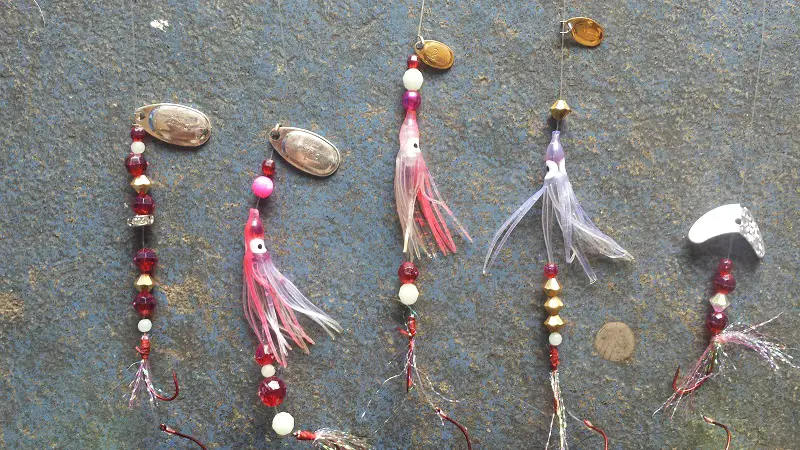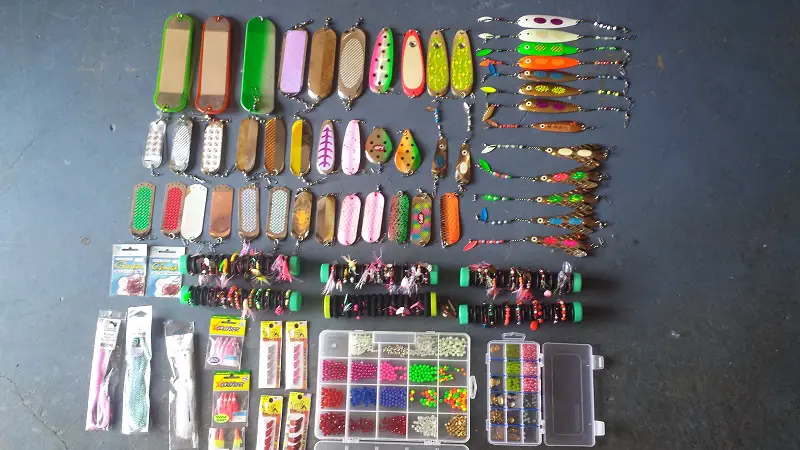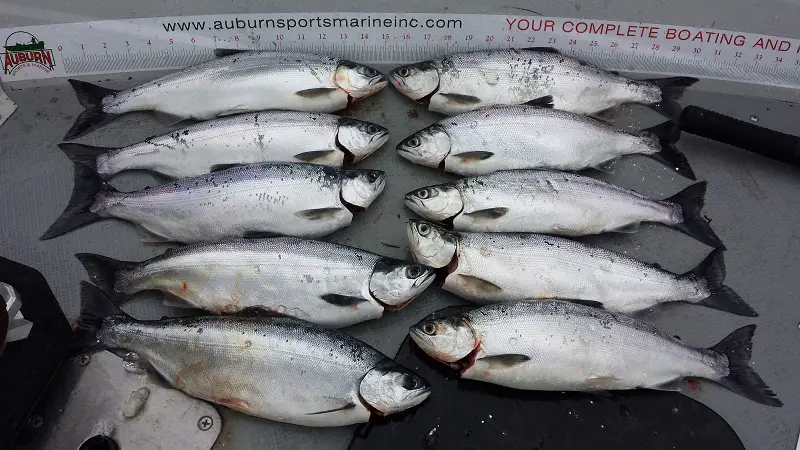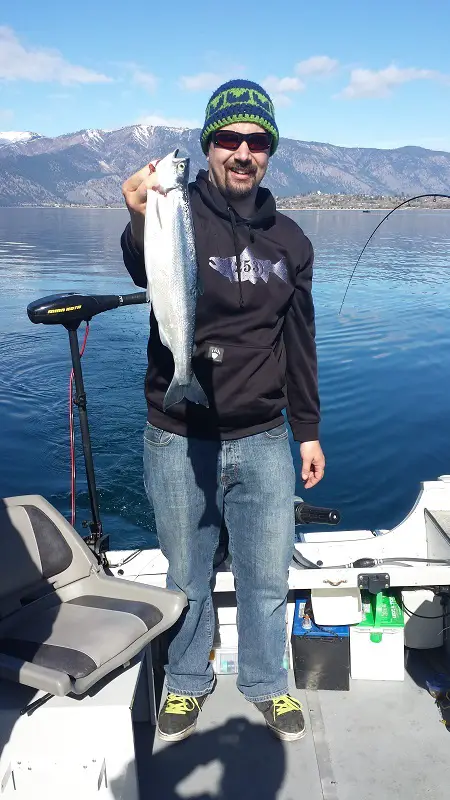Search
Latest Articles
Kokanee 101
by By gfakkema, May 23, 2014
I tie all my own gear, and I recommend doing so yourself if you don’t already. Many of my tackle decisions have come from taking info from many sources. Gary (Fish With Gary), and General Zog (Bill Herzog) have had the most influence on how I tie all my lures. If you haven’t read the articles that Gary has or any of the many articles that the Zog has written, I recommend that you do so, because they are very informative.
One of the first things that I want to address is lost fish. I have been reading a multitude of reports that complain about lost fish, whether on the way in or at the boat. I am not trying to brag or boast or show off, but I think that it’s important to say that my boat has landed over 130 kokanee this season. How many fish do you think were lost or got off? 10? 20?... I’ll give you a minute….
The answer is 4. My boat has seen 4 fish come un-buttoned out of 130+, and 2 of those were because we were horsing them in on a quad (4 rods going off with 2 people is a mess and with all that action, we honestly didn’t care if they got off). I am not trying to be mean, or harsh or even judgmental, but if you are losing more than 1 in 20 or 30 kokes, then you aren’t doing something right. In order to increase your lost/landed ratio, I would keep 3 important things in mind.
1)Up your game- I made 4 trips to Chelan this year and read all of Herzogs articles about rigging. The biggest thing I did to keep more fish was to change size/style of hook. Chelan has “big” fish and he recommended using 1/0 or #1 hooks. I thought that 1/0 was a little large, so I tied all my lures with #1’s. If you are going after fish that are 14”+, then leave those #4’s and #2’s at home. Trust me, #1 hooks are NOT too big.
2)Change your style- Make sure that you use drop-shot hooks. They make a fairly large difference over octopus hooks when it comes to landing that fish. Drop-shot hooks are made from a thinner gauge wire and penetrate deeper than a standard octopus hook. This thinner, smaller point also makes the trailer hook “stick” deeper in the fish with relatively little force.
3)Dip the tip- When fighting a kokanee, it is important to remember to take your time and enjoy the fight. There is no rush or need to horse the fish in. Most people laugh at me when I tell them to stick the rod tip INTO the water, but it is one of the most important things I do when reeling in a fish. When you put the rod tip 6”-12” under the water, it will want to pull the fish in under the surface. I have seen too many people lose fish when they get to the surface because they thrash and jump and do everything possible to spit that hook. If you put the tip into the water, you essentially keep them away from the surface. The resistance of the water will help to keep them on the hook(s). It should also go without saying that you want your rod to be perpendicular to the gunnel of the boat. This gives the rod the most opportunity to bend and give as the fish fights.
Now onto the tackle. Like I stated before, I tie all my own. If you want a quality product, for cheap and exactly the color and style that you want, you will have to tie your own. I bought lures for years, but could never find some of the “styles” that I wanted. Here is how I tie all my set-ups.
Tie on 2 red #1 drop-shot hooks onto a 2’-3’ piece of flouro leader. I use 15# and tie the 2 hooks about ½” from the eye of the trailer to the bend of the lead hook. I then use pink, silver and UV pearl flash (about 3-6 strands of each color) and tie them onto the top/lead hook. I then trim the flash so that it extends about ¼” past the bend of the top/lead hook. Now you’re ready to put on your beads, hoochies, blades etc.
Flash!! Use that Flash! I can’t state enough how many more fish started biting once I put flash on. I’ve used the exact same dodger and lure combos on both sides of the boat, with the only difference being the flash (one side had flash, one side did not). Guess what, the side with the flash always got hit more. I now tie all my lures with a bit of flash in there.
Contrast! If you’ve read any of the articles by Gary (Fish With Gary), you would know that contrast is a major part of kokanee fishing. I try to tie all of my rigs with some sort of contrast to break it up. If you look at my rigs, you will see contrast built into them all, even inside the hootchie skirts. You can use size to provide contrast (big bead, small bead, big bead…). Even if the beads are the same color, their size difference gives them contrast. Vary the color combos (dark bead, lighter bead, dark bead…). You can also combine the contrast (big dark bead, small light bead, big dark bead…). Just make sure that you use contrast, and it will pay off.
Metal! If you have ever read ANYTHING from General Zog, you would know that he is obsessed with metal, especially real gold and silver plated materials. Nickel and brass reflect less than 20% of the available light whereas real gold and silver plated blades reflect up to 90% of the light. This can make a huge difference on whether or not your offering gets seen. When I made the switch to real gold and silver blades, I noticed a huge difference in the number of takedowns. They are expensive, but they are well worth the price because they WILL get you more fish.
Leader length- I have gotten quite a few questions regarding leader length on different set-ups. General Zog recommends that measure your leader length from the bend of the trail hook to the bottom of the snap on the dodger, this way you have consistent leader lengths for all your tackle. If you are using a 3/0 or 2/0 dodger, he prefers a 14.5” leader length. If you are using wobblers or 4/0’s, he prefers a 13.5” leader length. All of his leader lengths are in reference to the Chelan kokanee article that he put out a few months ago. I imagine that he only had Chelan in mind when writing the article, but I have used the same theory on the west side for some time now and it seems to be doing pretty well for me. I only have a couple exceptions to his rules that I have adapted for the west side. The first, don’t even bother with the 14.5” length. I have tied all my leaders to 13.5” (regardless of dodger size) and have been pretty happy with the action. If I don’t like the action on a lure, or I want more action, I simply up the size of my dodger. I have found that a 13.5” leader length on a 2/0 dodger will give you more than enough action.
Tying/Loops- I didn’t mention this before, but it is worth noting that I tie loops in all my gear so that it is easy to change and store. As stated above, tie your 2 hooks on (egg loop knot), then your flash, then your beads/hootchie/blade. After this, measure your desired leader length (I like 13.5”) and add ½” to the length to account for the know (so in my case, I measure to 14”). Find your mark (again, me it’s 14”) and fold or twist the line. Now I tie a double surgeon loop knot on the end and then trim the tag. If you did it correctly, you will have as tiny of a loop as possible, with a tight knot and about ¼” of tag end hanging off.
Dodger Size- In the past, I pretty much only used the 4/0 dodgers. After many trips to Chelan this year, I have been experimenting with larger dodgers and different styles of wobblers. I have found that playing with dodger sizes has increased my hook up ratio. Most of my decision on size and color will come from conditions (i.e. available light, water clarity, water color and lure selection/color). I almost always run a larger dodger on my lower rods though. For instance, if I am running 4 rods, I will put a 2/0 on the lowest/deepest rod, a 3/0 on the next up and 4/0’s on the two upper rods. The bigger dodgers do better down low because there is less available light and the larger size helps reflect more light and give more action. Trust me, try some larger dodgers down low and you will not regret it. I also have many of my 2/0 and 3/0 dodgers that I put UV tape on to give it that extra pop. Get a 2/0 and 3/0 50/50 and some silver with UV. These have produced like crazy on Chelan and have accounted for many fish on American.
Bait- If you don’t know already, only use SHOEPEG CORN. Shoepeg has an amino acid in it that trigger kokanee to bite. You can use it plain, scent it, dye it, whatever, just use it. My top producer this year has been some form of bloody tuna scent. I usually mix it with others too, but the majority of my scent has been bloody tuna. Many others use maggots and worms and what not, but I only use corn. Maggots are kind of a pain to deal with IMO, trying to put them on the hooks in a bouncing boat can result in hooked fingers. I have tried maggots in the past, but never really noticed a difference in the number of hookups. Also, the maggots are like $4-$5 a jar. I can buy 3 or 4 can of shoepeg for that price and have bait for months.
One area that I notice a lot of kokanee anglers disagree on is the issue of what bait, how much and where. I only put corn on the top/lead hook. I will usually start with one big kernel on the top/lead, and that’s it. DO NOT PUT BAIT ON THE TRAIL HOOK!! You do not want the kokanee to even know that the trail hook is even there (hence why I also cut my flash above the trail hook). If you put bait on the trail hook, the fish may see this and want to bite it. You do not want the fish to bite the trail hook, just the lead hook. If things are slow or I’m not getting hit, I may add an additional kernel to the mix (again, on the lead hook).
I am not sure how much the scent reacts with the amino acid in the corn, so I usually try to add a non-scented/non-dyed piece in there as well. I use one medium kernel of scented/dyed and one medium natural kernel. I believe that the natural kernel helps give that extra amino acid that the dye/scent/cure might alter. Also, make sure that you orient the corn so that the open end(part that used to be on the cob) is facing the fish. This makes the kernels more streamline and lets the scent escape through the opening right into the kokanee’s nose.
Set-back- I started using a longer set back while fishing in Chelan due to the water clarity. I tried to use a shorter set back when I came back to the west side, but noticed that I wasn’t having as much luck. When I went back to my longer set backs, I noticed that I got more fish. My theory is that it gets the offering away from the shadow and noise of the boat. So, here’s how I do it. The lowest rod gets an 80 pull set back. The next rod up gets a 90 pull set back and the two top rods get 100 pull set backs. If only using 2 rods, then I go 85 and 100. All of this is regardless of depth.
I also believe that the longer set back means that the fish will get hooks farther away from the boat. This is important because the fish has to fight for much longer before it even sees your vessel. The longer fight tires the fish out more and it will have that much less steam when you get it to the net.
Direction- I always try to troll away from the sun. So, if the sun is rising in the east in the morning, I will try to troll in a westerly direction. This accomplishes 2 things. First, it gets the shadow of the boat out in front of you and away from your offerings. Secondly, the more direct sunlight on the dodger/lure gives it that extra reflectability. I can’t tell you how many times I have trolled away from the sun and gotten hit after hit, then turned around and went into the sun without a single hit. Turn back around to go away from the sun and the bites start coming again. Try this, I believe that you will notice more hits going away from the sun. When the sun hits high in the sky (afternoonish), direction is not nearly as important.
Wind- I have found that if you follow the wind, you will find the kokes. My theory is that the feed (plankton) cannot move freely on it’s own and is at the mercy of the wind/current. When the wind is blowing, it will push the feed until it hits some structure, shore, underwater obstacles etc. Follow that wind and pound that structure. For example, if the wind is coming from the west, hit the eastern shore line for a bit.
The Author with a Lake Chelan 18 incher.




